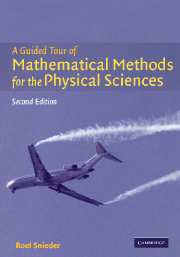Book contents
- Frontmatter
- Contents
- Preface to Second Edition
- Acknowledgements
- 1 Introduction
- 2 Dimensional analysis
- 3 Power series
- 4 Spherical and cylindrical coordinates
- 5 Gradient
- 6 Divergence of a vector field
- 7 Curl of a vector field
- 8 Theorem of Gauss
- 9 Theorem of Stokes
- 10 Laplacian
- 11 Conservation laws
- 12 Scale analysis
- 13 Linear algebra
- 14 Dirac delta function
- 15 Fourier analysis
- 16 Analytic functions
- 17 Complex integration
- 18 Green's functions: principles
- 19 Green's functions: examples
- 20 Normal modes
- 21 Potential theory
- 22 Cartesian tensors
- 23 Perturbation theory
- 24 Asymptotic evaluation of integrals
- 25 Variational calculus
- 26 Epilogue, on power and knowledge
- References
- Index
2 - Dimensional analysis
Published online by Cambridge University Press: 05 June 2012
- Frontmatter
- Contents
- Preface to Second Edition
- Acknowledgements
- 1 Introduction
- 2 Dimensional analysis
- 3 Power series
- 4 Spherical and cylindrical coordinates
- 5 Gradient
- 6 Divergence of a vector field
- 7 Curl of a vector field
- 8 Theorem of Gauss
- 9 Theorem of Stokes
- 10 Laplacian
- 11 Conservation laws
- 12 Scale analysis
- 13 Linear algebra
- 14 Dirac delta function
- 15 Fourier analysis
- 16 Analytic functions
- 17 Complex integration
- 18 Green's functions: principles
- 19 Green's functions: examples
- 20 Normal modes
- 21 Potential theory
- 22 Cartesian tensors
- 23 Perturbation theory
- 24 Asymptotic evaluation of integrals
- 25 Variational calculus
- 26 Epilogue, on power and knowledge
- References
- Index
Summary
The material of this chapter is usually not covered in a book on mathematics. The field of mathematics deals with numbers and numerical relationships. It does not matter what these numbers are; they may account for physical properties of a system, but they may equally well be numbers that are not related to anything physical. Consider the expression g = df/dt. From a mathematical point of view these functions can be anything, as long as g is the derivative of f. The situation is different in physics. When f(t) is the position of a particle, and t denotes time, then g(t) is a velocity. This relation fixes the physical dimension of g(t). In mathematical physics, the physical dimension of variables imposes constraints on the relation between these variables. In this chapter we explore these constraints. In Section 2.2 we show that this provides a powerful technique for spotting errors in equations. In the remainder of this chapter we show how the physical dimensions of the variables that govern a problem can be used to find physical laws. Surprisingly, while most engineers learn about dimensional analysis, this topic is not covered explicitly in many science curricula.
Two rules for physical dimensions
In physics every physical parameter is associated with a physical dimension. The value of each parameter is measured with a certain physical unit. For example, when I measure how long a table is, the result of this measurement has dimension “length”.
- Type
- Chapter
- Information
- A Guided Tour of Mathematical MethodsFor the Physical Sciences, pp. 3 - 15Publisher: Cambridge University PressPrint publication year: 2004



